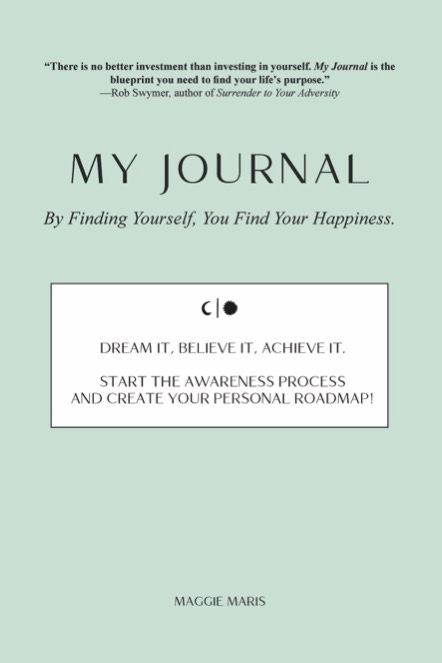Facing Fears and Trying New Things: Guest Post and Excerpt by Maggie Maris + Crochet Exercise by Kathryn Vercillo
A stop on the virtual book tour for My Journal, a guided journal published by the founder of Maggie's Way
This is how art and health intersect for one artist.
If you are interested in understanding this relationship in your own life: Order a Creative Health Assessment or Book a 1:1 Coaching Call.
As you know, I’m a fan of the virtual book tour as a way to not simply spread the word about a book but to build community and offer more to readers than simply what they get with a book purchase. So, I was happy to say yes when
of asked if I wanted to be a part of her virtual book tour for her new release: My Journal: By Finding Yourself, You Find Your Happiness.This is a journal with prompts and inspiration designed to help you find happiness in different areas of life. For my stop on the tour, I wanted to share the area that interested me most personally: Facing Fears. Maggie has generously allowed me to share an excerpt from that section of the journal and she has supplemented that by writing us a guest post about her own experience stepping out of her comfort zone and trusting her own creative intuition.
About Maggie Maris
“Maggie had a turbulent past, marked by undiagnosed learning challenges, a demanding home life, and the devastating loss of her father, which fueled years of depression, anxiety, and misdiagnoses. Initially masked by people-pleasing and perfectionism, this internal struggle culminated in a total breakdown. Amidst this darkness, she embarked on a transformative journey of self-discovery, shedding labels and seeking the root of her pain. Her introspective quest led her to heal and discover her true self and the courage to advocate for herself.” She uses her own experience to help others through “Maggie’s Way, a methodology in mental well-being that focuses on individuals under significant pressure in our current society.” And she offers this to us now through My Journal as well.
For more information, visit MaggiesWay.nl and connect on Instagram @maggiesway and LinkedIn.
Facing Fears: Stepping Out of Your Comfort Zone
Guest post by Maggie Maris
When it comes to stepping out of our comfort zones, we often face two major obstacles: laziness (procrastination) and fear (the fear of trying new things). Humans tend to seek comfort, but if we truly want to grow, learn, and lead an exciting life, we must be willing to try new things. Changing habits and mindsets is key to achieving our goals. Are you aware of these behaviors in yourself?
Getting out of your comfort zone can sometimes feel like facing real fear. Being a procrastinator can also hinder progress. At times, we may need a push to get started, but often, we are unaware of our own behaviors. By becoming aware of our actions, we can understand why we behave in certain ways. This awareness allows us to start making positive changes. In my book, I guide people through this process.
Let me share a personal experience: I used to be very insecure about my talents, especially when it came to painting. I would paint but keep my work hidden until I was completely satisfied, which was rare.
I had strict rules for myself, and negative thoughts plagued my mind: "You cannot paint! Why do you think you are talented?" I was afraid of others' opinions and held limiting beliefs.
Another example is my experience with interior design. I always relied on others to decorate my home, believing I had no taste in interior design. It wasn't until I finished building my house that I realized I had my own eye for beauty. I had been holding myself back with my own thoughts. I felt free and empowered when I let go of these limiting beliefs. I now know that I can trust my own taste and judgment.
I slowly started to believe in myself and challenged myself to try new things. I remember being scared on the first day of a course, worrying about parking, getting lost, being late, or not fitting in. But with each new experience, my fear diminished. Now, I feel free almost every day. I am no longer scared because trying is the first step to growth.
As Pippi Longstocking says, "I have never done it, but I think I can." I now feel free and unafraid. I try new things, and while they're not always easy, they make me happy. I want everyone to experience this freedom and growth.
As Brené Brown says, "Nothing has transformed my life more than realizing that it is a waste of time to evaluate my worthiness by weighing the reaction of the people in the stands."
So, give yourself permission to be you! Dare to be!
Facing Fears, Excerpt from My Journal by Maggie Maris
Taking care of yourself also means doing things that you dread, don’t want to do, or are afraid to do. These can be divided intolaziness and fear. Are you too lazy to do something? Or are you genuinely afraid that you can’t do it?
To do: Create a to-do list with tasks you have been dreading for a while.
Think of administrative tasks or that annoying chore at home. When are you going to do this? Consider doing one task per week, depending on how time-consuming the task is, or maybe even two! Put it in your calendar if necessary. Bet you’ll feel good once it’s done!
Apart from things you don’t feel like doing, there may also be things you want to do but are afraid to do. You may be afraid of failure or afraid that something might happen to you or someone else. But deep down, there is always a flicker of desire for something you truly want.
So why not go for it? A big part of taking care of yourself is stepping out of your comfort zone. Doing things that genuinely make you happy. Think about that one thing you’ve always wanted to do. How proud would you be if you actually did it? Can you feel the excitement building up? Realize that fear is nothing more than a thought followed by a feeling.
A thought is not the truth or the reality. You can breathe through it when something feels scary, and you’ll see that nothing terrible happens. You can do it. Maybe not the first time or the next time, but eventually, you will. By facing these fears, your insecurity transforms into self-assurance. See, you are capable of doing it, aren’t you?
To do: Face your fears.
Journal responses to the following questions:
What would you do if fear wasn’t an issue?
What could happen that you’re so afraid of?
Worst-case scenario?
Is this a realistic fear?
What do you need to do to set aside this fear?
Do you need any help with it?
What is the best-case scenario?
What if nothing goes wrong?
How will you overcome this fear?
Facing Fears: An Excerpt from Hook to Heal by Kathryn Vercillo
In my book, Hook to Heal, I developed 100 crochet exercises designed to help crafters work through various challenges in order to live a fuller, richer, happier, more peaceful, more connected, joyous life. The 100 exercises are divided into ten categories, with ten exercises each, and one of those categories is, of course, Facing Fears. I share some of my own stories about facing fears and provide various exercises for working through different fears including fear of change, new things, and the unknown, fear of not being perfect, not being good enough and fear of rejection.
I believe, because it’s been true for me, that we can practice things in art/craft in a way that integrates deeply into our bodies/minds and resolves issues in a sort of magical way. I believe that facing fears in an easy digestible way through crafting, which is low stakes, teaches us how to face fears in other harder areas of life. Today, I’ll share with you one of the exercises from my Facing Fears chapter. The exercise for the Fear of Trying New Things seems most relevant to what Maggie has shared.
Facing Fears Crochet Exercise: Fear of Trying New Things by Kathryn Vercillo
The exercise: Practice skill-building in crochet by learning new techniques.
The purpose: Confront a fear of failing at new things by slowly adding new techniques to your crochet skill set.
In depth: The greatest thing about crochet is that once you learn the basics, you can make just about any item you could ever want. And yet, there are so many techniques in crochet that you could continue learning new things all of the time. The idea here is to build upon your existing skill base in crochet by taking the chance on learning something new. You can always fall back on your old favorite techniques as a safety net for comfort. (Remember that list of safe projects you created in a previous chapter?!)
Exercise steps:
Make a list of crochet techniques that you already know, which you can keep as a reminder of how great you are at the craft in case you have missteps as you learn new things.
Make a list of at least twenty things in crochet that you don’t know how to do yet. It could be as simple as learning new joining techniques or as complex as discovering an entire new niche of crochet. (Some of the lists you’ve made in previous chapters can be a good starting point for Steps One and Two here. This exercise is an expansion on letting go by “being a beginner”; this time you are directly facing all of the fears that arise when trying something new.)
Choose the item off of the list that sounds the least intimidating and learn it. That might mean that you take a class or simply that you sit down for an hour and teach yourself the technique.
Practice that technique every day for a week, or a month, or however long it takes until you feel absolutely comfortable that you’ve essentially mastered this new skill. Notice your fears, notice why you want to quit, notice what’s difficult. Being a beginner brings up fears; you have the strength and ability now to deal with those. Use your affirmations again if they help.
Go back to the list you made in Step One and add this new skill to your list of techniques that you know.
Go back to the list you made in Step Two, cross off the item you’ve already learned, add a new item to the bottom of the list (so that it’s always growing).
Repeat steps three - seven again and again!
Tips:
Regularly seek out new information about crochet and see what inspires you. Add those things to your list. For example, I often look at the portfolios of crochet artists and consider what techniques they are using that I don’t already know how to do. Even if it seems completely out of reach, I put it on my list. Who knows - I may be ready to learn it someday.
What are the boundaries of your comfort zone in crochet? Step just to the line of those boundaries, challenging yourself without making the process unbearable.
Be willing to work through your frustrations. You have to be a beginner sometimes and it can be difficult to learn a new technique. You may decide you don’t like the technique and give up. It’s okay if you don’t like it in the end but persist through that and learn to do it at least moderately well. Even if you never use the skill, the confidence you build up by learning it will serve you well in both your crafting and your life.
Don’t overlook the simple things. Many of us have developed shortcuts and cheats for basic steps in crochet and could benefit by going back and learning how to do those steps differently. A book I highly recommend for examining this is Dora Ohrenstein’s The Crocheter’s Skill-Building Workshop: Essential Techniques for Becoming a More Versatile, Adventurous Crocheter.
Taking it further: Take a bigger risk by trying a project that you know is a little bit too hard for you in terms of your skill set. The basic exercise here asks you to choose the technique that seems least challenging but in this variation you should choose one that seems really intimidating. See how far you can get with it. See what emotions it brings up for you. Work on it. If you get overwhelmed, go back to one of the easier-to-learn techniques or even back to the self-care chapter and then return to this variation on the exercise later.
Maggie Maris Virtual Book Tour
Virtual book tours are so fun because authors can share excerpts, interviews, thoughts, images, etc. that just didn’t make it into the published book for one reason or another. This tour kicked off on World Teen Mental Wellness Day when Angela Williams, founder of Angela’s Voice and author of Loving Me: After Abuse, did an interview with Maggie for on how journaling can help teens.
Another stop I particularly enjoyed was Maggie Maris in conversation with Marva Bailer, author of Be Unexpected discussing: “working mothers’ struggles, the importance of self-care and positivity, the elusive quest for work/life balance, and the importance of finding your voice.”
Visit
this week for her stop on the tour. See all tour stops here.If you read this far, perhaps you liked the work. The work takes work. Support it if you can:









